yogabook / asanas / child pose
Contents
balasana
„Child pose“
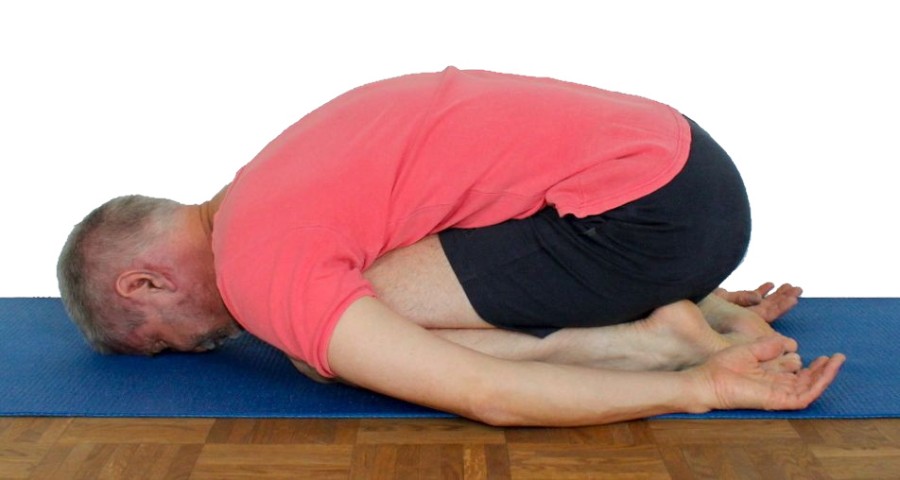
 instructions and details with working links as PDF for download/print
instructions and details with working links as PDF for download/print
Feedback: We would love to hear what you think about this description, give us feedback at:
postmeister@yogabook.org
last update: 30.12.2018
Name: balasana
Trivial name: Child’s pose
Level: A
- Classification: A
- Contraindication
- Effects of
- Preparation
- follow-up
- derived asanas
- similar asanas
- diagnostics
- Instruction
- details
- Variants
Classification
classic: pose on the floor
psychomental: calming
physiological: stretches the back and buttocks
Contraindication
The basic pose is contraindicated in the case of disc hernia in the lumbar spine, even if the bending moments in the spinal segments are rather low due to the supported upper body. However, it should be possible to practise the head supported variation without any problems if the head is sufficiently elevated.
Effects
Preparation
No preparatory exercises are given for this pose.
Follow-up
Derived asanas:
Similar asanas:
Diagnostics (No.)
Variants:
Instructions
- Sit on your lower legs.
- Bend forwards from the hip joints and rest your upper body on your thighs.
- If possible, rest your head on the floor. If necessary, use a block or other elevation to support the head.
- Place your arms comfortably behind you in the direction of your pelvis, palms facing the ceiling.
Details
- Child’s pose is purely a resting pose that is as comfortable as possible and has no ambitions in terms of stretching, strengthening, coordination or similar, even though it stretches the back very gently.
- At first glance, child’s pose is somewhat similar to virasana forward bend. However, as the buttocks rest on the heels – if the thighs are sufficiently flexible – it is less demanding in terms of the health of the knee joints and the flexibility of the thighs. While in virasana the buttocks should sink to the floor, which requires good flexibility of the monoarticular quadriceps, in child’s pose good average flexibility is sufficient to rest the buttocks on the heels. In the forward bend, the buttocks may want to lift up again a little because the upper body presses the pelvis down less. If the bottom hanging in the air is perceived as uncomfortable or stress is felt in the knees, the bottom can be placed on an elevation, which often completely eliminates such problems. This doesn’t detract from the child’s pose any more than it would be desirable in virasana or would be used carelessly, as the aim is to stretch the monoarticular quadriceps, which requires the pelvis to be lowered as far as possible. In supta virasana, for example, these would be significantly less affected.
- As an alternative to placing the arms backwards, they can also be stretched forwards past the head. Depending on the flexibility of the quadriceps, i.e. the height of the pelvis, and the flexibility of the glutes, and thus the height of the upper body, this requires more or less flexibility in the shoulder joints in the sense of frontal abduction. It goes without saying that the arms should be completely relaxed and not stretched actively.
- If the head cannot be placed on the floor or only with tension in the neck, a support for the head should be used, unless the child’s pose is performed precisely because of the slight stretching effect on the back or cervical spine.
- Similar to virasana, a tendency to cramp in the sole of the foot or a stretching effect in the dorsiflexors (front of the lower leg) can also occur here. The former should always be avoided, the latter can be decided to what extent it is detrimental to the desired relaxation. In all cases, these two effects can be minimised or eliminated by supporting the ankle area, for example with a piece of mat rolled up tightly and with little compression.
- The arms should only be turned out so far that there is minimal tension in the rotators. Unlike in savasana, for example, the forearms are more pronated so that the back of the hand points towards the floor. This means that both a relaxation pose with supination and one with pronation are available and the rotation of the upper arms differs significantly.
- The knees are normally hip-width apart, but can also be held further apart, which is normally perceived as even more relaxing because flexion in the hip joints is easier and also because breathing is less restricted. If the thighs are opened so far to the side that the upper body hangs almost completely free between the legs, the pose is usually perceived as less relaxing and the head may have to put an uncomfortable amount of weight on the floor.
- Similar to virasana and supta virasana, it is also advisable to pull the calves outwards when taking the pose.
- In rare cases, a tendency to cramp in the rectus femoris or tensor fasciae latae may occur or the ventral hip area may feel shortened after the pose. In this case, limit the flexion angle in the hip joints or relieve the flexion by using a support under the head or performing the „wide“ variation and supporting the whole upper body accordingly.
Variants
Legs wide
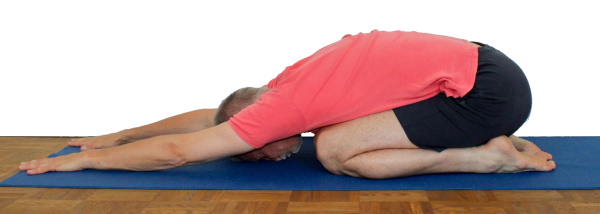
Instructions
- Take the pose as described above, but place your arms in front of your head instead of next to your body. The arms are not actively stretched but remain passive.
Details
- In some cases, this variation can be more comfortable than the standard variation because the chest, lightly supported by the arms, lies less heavily on the thighs. Together with the frontal abduction of the arms, which moves the sternum cranially, this makes it easier to inhale.
Legs wide
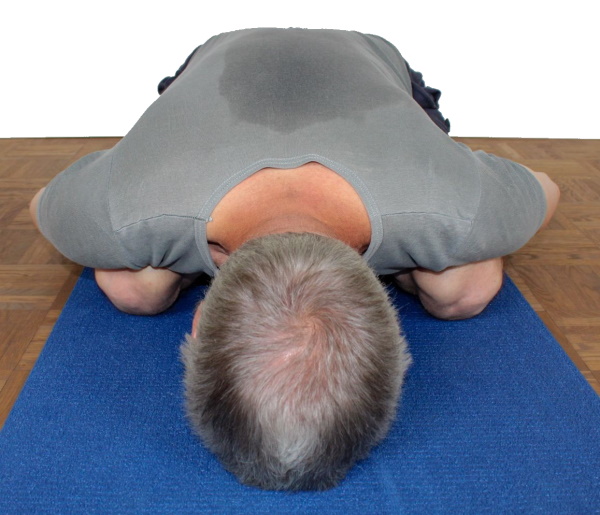
Instructions
- Take the pose as described above, but keep your legs significantly wider open so that your upper body, especially your stomach, has room between them.
Details
- This variation makes breathing easier but requires more flexibility, especially in the short/monoarticular hip extensors, i.e. the glutes in particular. It may be necessary to use a support for the buttocks otherwise more tension will be felt there. If the head exerts an uncomfortable amount of pressure on the floor, use a support there too.
Head support
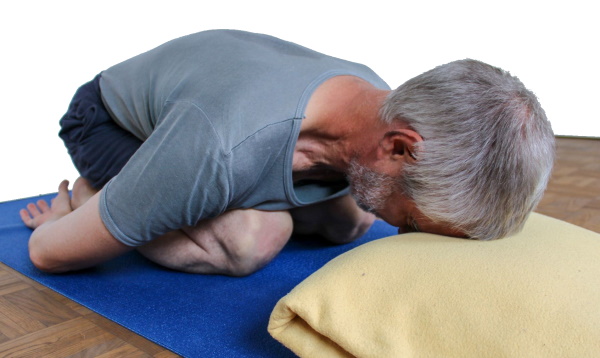
Instructions
- Take the pose as described above, but support the head as much as necessary so that there is no or only the desired stretch in the neck or back.
Details
- ..
Bottom supported
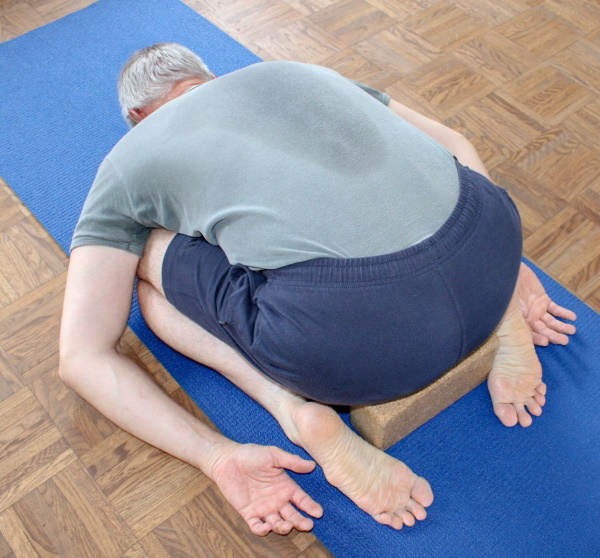
Instructions
- Take the pose as described above, but place the buttocks on an elevation that ensures that the knees do not show any discomfort and, if too intense, the quadriceps only feels the desired stretch.
Details
- This variation is primarily intended to enable the pose in the event of knee damage. Support the buttocks until there is no more pain. It is also useful for significantly shortened quadriceps if the sensation of stretching would otherwise spoil the character of the exercise.
